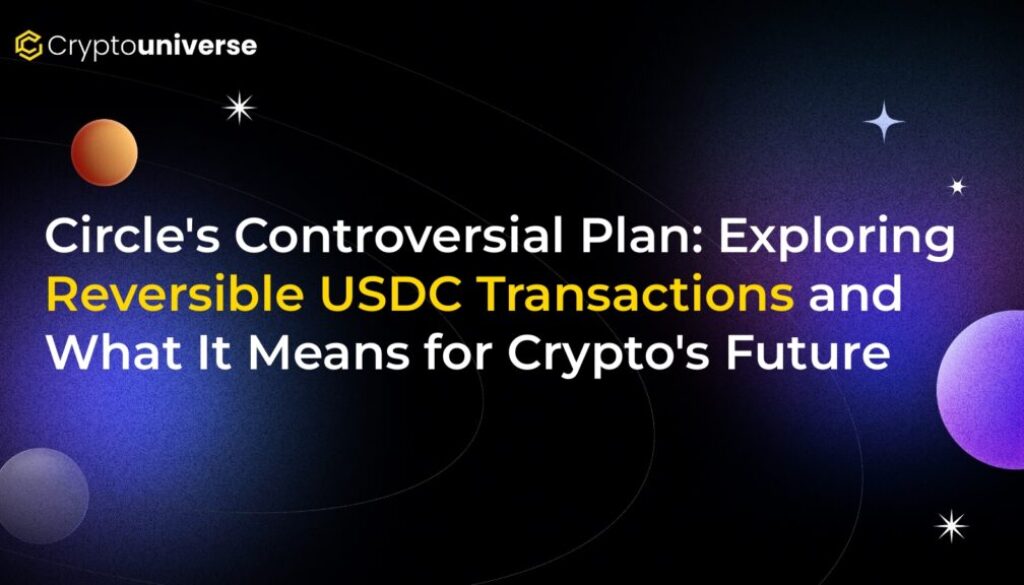Circle’s Controversial Plan: Exploring Reversible USDC Transactions and What It Means for Crypto’s Future

A New Direction for Stablecoins?
The world of cryptocurrency was built on a simple, powerful promise: your transactions are yours, final and irreversible. This principle of immutability has been a cornerstone of the industry, a clear break from the traditional financial system where banks can reverse charges. But now, one of crypto’s biggest players is questioning that foundation.
Circle, the company behind the world’s second-largest stablecoin, USDC, is exploring a feature that could change everything: reversible transactions. This move aims to protect users from the rampant fraud and hacks plaguing the industry, but it also sparks a fierce debate about the core values of decentralization and censorship resistance.
The Tension Between Finality and Safety
In a recent interview, Circle’s president, Heath Tarbert, acknowledged the “inherent tension” in this proposal. On one hand, the beauty of crypto lies in its ability to offer immediate and final settlement—once a transaction is confirmed on the blockchain, it’s set in stone. On the other hand, this finality is a double-edged sword, leaving victims of theft with little to no recourse.
“We are thinking through whether or not there’s the possibility of reversibility of transactions,” Tarbert explained, highlighting the challenge of implementing a safety net without sacrificing the core benefits of blockchain technology. The goal is to find a middle ground that could help stablecoins like USDC become a trusted part of the global financial system.
The Great Debate: A Necessary Evolution or a Betrayal of Ethos?
The concept of Circle exploring ‘reversible’ USDC transactions in break from crypto ethos has split the community, with strong arguments on both sides.
The Case for a Safety Net
Supporters argue that a mechanism for transaction reversal is a crucial step for crypto’s mainstream adoption. Here’s why:
- Combating Fraud and Hacks: Billions of dollars are lost each year to crypto scams and exploits. Reversibility could offer a lifeline to victims, allowing them to recover stolen funds.
- Building Mainstream Trust: The average person is accustomed to the protections offered by banks, like fraud alerts and chargebacks. Introducing similar safeguards could make stablecoins less intimidating and more appealing to a broader audience.
- A Real-World Precedent: We’ve already seen a form of this in action. In May, the decentralized exchange Cetus was exploited for over $220 million. Validators on the Sui network managed to freeze $162 million of the stolen assets and, following a governance vote, returned them to the protocol. While controversial, many saw this as a positive step in protecting users.
The Slippery Slope of Centralization
For crypto purists, the idea of reversible transactions is an alarming departure from the industry’s founding principles. The primary concerns include:
- Undermining Decentralization: If a central entity like Circle can reverse transactions, it fundamentally compromises the decentralized nature of the network. It reintroduces a trusted third party, the very thing Bitcoin was created to eliminate.
- Risk of Censorship: Who decides which transactions are fraudulent? A centralized reversal function could potentially be abused by corporations or governments to freeze funds or censor transactions they don’t approve of.
- Challenging Property Rights: Immutability means that once you receive crypto, it is unequivocally yours. Reversibility introduces a scenario where your assets could be clawed back without your consent, challenging the concept of digital ownership.
Part of a Broader Institutional Push
This exploration of reversible transactions isn’t happening in a vacuum. It aligns perfectly with Circle’s broader strategy to cater to institutional and enterprise clients. The company is actively working to bridge the gap between decentralized finance (DeFi) and traditional finance (TradFi).
A key part of this strategy is Arc, Circle’s upcoming layer-1 blockchain. Designed as an “enterprise-grade foundation” for stablecoin payments and capital markets, Arc will use USDC as its native token. By integrating with platforms like Fireblocks, which serves over 2,400 banks, Circle is positioning Arc—and by extension, USDC—as the go-to solution for financial institutions entering the digital asset space. For these institutions, features like compliance and transaction reversibility aren’t just a bonus; they’re a necessity.
What’s Next for USDC and Stablecoins?
Circle’s potential move forces the crypto industry to confront a difficult question: to achieve mass adoption, must it sacrifice some of its core ideals? The path forward is unclear. Any implementation of reversible transactions would need a robust and transparent governance model to prevent abuse.
For now, the discussion remains theoretical. However, it signals a significant shift in how major players view the future of stablecoins. As crypto continues to mature, the line between the old financial world and the new may become increasingly blurred. Whether this leads to a safer, more accessible financial system or a diluted version of crypto’s original vision remains to be seen.


